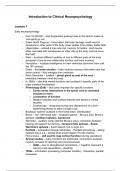Summary
Introduction to Clinical Neuropsychology - summary (grade 8.5)
- Course
- Institution
- Book
This is a summary of the course Intro to Clinical Neuropsychology written in the year 2023/2024, from which I received the grade 8.5. It is based on the lectures, while covering the most important parts of the book. It includes pictures and graphs present in the book. Some parts of chapters are ...
[Show more]



